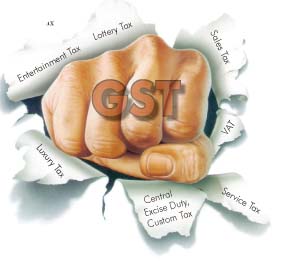Nowadays the front page news is all about the Goods and Service Tax (GST). GST is a comprehensive tax which is to be implemented in India . it will replace all the indirect taxes levied on goods and services by the Indian central and state governments. One of the biggest tax reforms in India , it will break the tax barriers between the states and also unite India by a uniform tax rate. The type of GST the government is planning to bring into force is a DUAL GST SYSTEM. In this, a central GST tax and a state GST tax will be levied on taxable value of the transaction.
GST will lead to the annulment of various other taxes such as octroi(it is a local tax collected by the state government or the city on articles brought into a town for local use), Central Sales Tax, State-level sales tax, entry tax, stamp duty, telecom license fees, turnover tax, tax on consumption or sale of electricity, taxes on transportation of goods and services, etc thus giving a huge sigh of relief to the people of the country. It is also anticipated that such a tax reform will encourage the economic development, help build a transparent and corruption free tax administration.
Primarily , the idea of GST was brought up by the Vajpayee government in the year 2000. It started the discussion by setting up an empowered committee. The then finance minister MR. Palaniappan Chidambaram made announcement during the central budget of 2007–2008 that it would be introduced from April 1, 2010 and that the Empowered Committee of State Finance Ministers, on his request, would work with the Central Government to prepare a road map for introduction of GST in India.
WHO WILL BENEFIT FROM GST?
Under GST, the taxation burden will be divided equitably between manufacturing and services and will be is levied only at the destination point, and not at various points (from manufacturing to retail outlets) making the whole process easy for the manufacturers. Currently, a manufacturer needs to pay tax when a finished product moves out from a factory, and it is again taxed at the retail outlet when sold.
Since the burden of taxes will be divided between manufacturers and services, it is estimated that GST will raise 15$ billion each year and elevate employment and exports and therefore help in eradicating the major problems of India.
WHY ARE SOME STATES AGAINST THE IMPLEMENTATION OF GST?
Some states fear that if the enforcement of GST will lead to a lower uniform tax rate than the existing rates then it will hit their tax collection.
The articles on which GST will not be applied are alcohol, tobacco and petroleum products.
Recently, under the BJP government , it has been announced that the GST tax reform is scheduled to be rolled out from April 2016. And the finance minister MR. ARUN JAITLEY has ensured that no state will lose money and it would be a win-win situation for both the centre and the state.
The implementation of GST has missed several deadlines due the unanimity of the states on certain significant issues related to this new tax rule.
Click here for government certification in Accounting, Banking & Finance





6 Comments. Leave new
VERY INFORMATIVE
Very informative and quite easy to get. Good work!
very informative!
Informative and well written article.. keep going!!
Very informative!
nice…